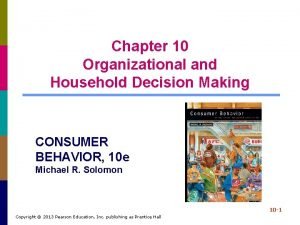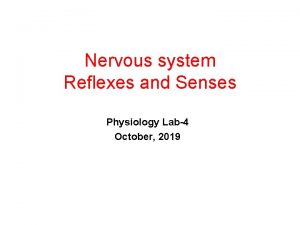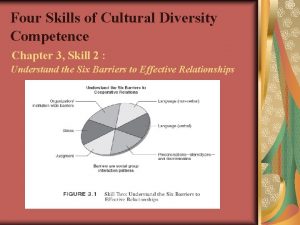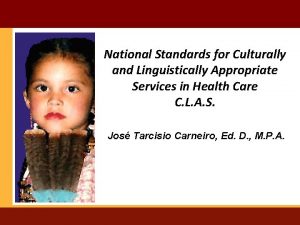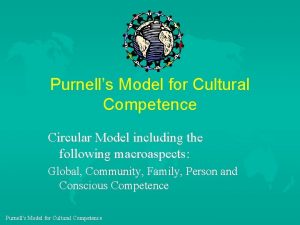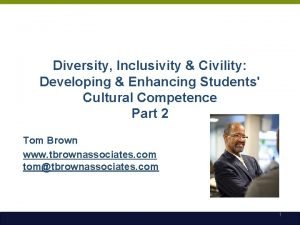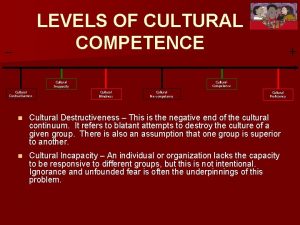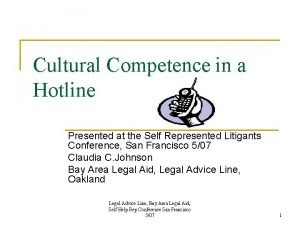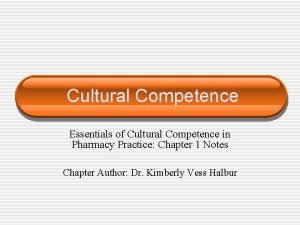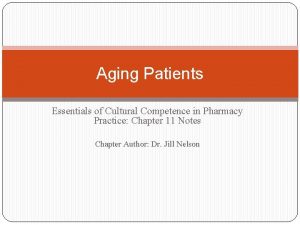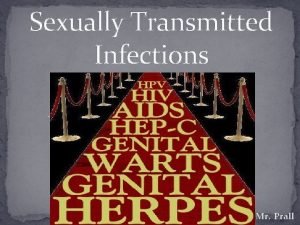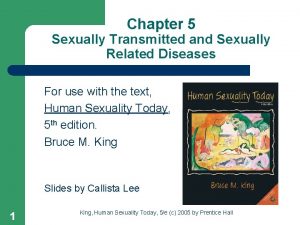CULTURAL COMPETENCE WITH SEXUALLY DIVERSE PATIENTS From Consensual





















- Slides: 21

CULTURAL COMPETENCE WITH SEXUALLY DIVERSE PATIENTS: From Consensual Non-Monogamy to Kink. What you should know. Amy Jacobs, LMSW Michigan Medicine HIV/AIDS Treatment Program Contributor: Jennifer Schwartz, LMSW Corktown Health Center, Detroit MI

GUIDELINES FOR TODAY'S PRESENTATION: • This is a learning space – Please ask questions here (as opposed to asking your clients later) • Assume the best from other participants • Step up/Step back • “Oops” vs. “Ouch” • Speak from your own experience • Observe the confidentiality of those who speak in this space today • Don’t “yuck” someone else’s “yum” • Take care of yourself • Anything else?

SO WHAT DO I MEAN BY “SEXUALLY DIVERSE? ” • For the purposes of this presentation, I am specifically referring to patients who are participating in non-traditional relationship structures – specifically BDSM and CNM. • Kink/BDSM: Bondage/Discipline/Dominance/Submission/Sadism/Masochism/Slave/Master. • Yes, I mean whips and chains and handcuffs…. • CNM: Consensual Non-Monogamy/Ethical Non-Monogamy • Polyamory, Polyfidelity, Open relationships, Swingers, Relationship Anarchy, Monogamish, Triads, Quads, and more, Oh My!

SO WHAT DO I MEAN BY “CULTURAL COMPETENCY? ” • Inclusive assessments to capture all relationship styles • Obtaining a basic knowledge so your patients aren’t spending their appointment time teaching you about their relationships • Acceptance and understanding • Judgement-free services • Appropriate care based on patient’s individual relationship needs

CONSENSUAL NON-MONOGAMY • What is it? • What do these relationships look like?

TYPES OF CONSENSUAL NONMONOGAMY: • • Polyamory Polyfidelity / Poly-exclusive Monogamish Open relationships Relationship Anarchy Swinging or “The Lifestyle” Polygamy Polygyny • • Polyandry Play partners Friends with Benefits Monogamish DADT Mono/Poly relationships …and more

KINK AND BDSM • What is it? • What do these relationships look like?

TYPES OF BDSM/KINK: • • • Dominant/submissive M/s or Master/slave Top/bottom Daddy or Mommy /boy or girl Play Partners Primal or Predator/prey Leather identities Animal identities, including puppies, kitties, ponies and their Handlers Leather families or houses • • • Play space or dungeon Sensation play Service Edging Impact Play, spanking, caning, slapping, flogging • Shibari/Kinbaku/rope or other bondage or restriction • Cutting, piercing, needles, knife play or other blood play • Fire play, cupping, branding, wax • • • Humiliation/degradation Identity Play Fetish Breath play, choking Psychological play Medical play Exhibition/voyeurism Scatological play Consensual non-consent Scene …and more

WHY DO YOU NEED TO KNOW ABOUT THIS? § 4 -5% of American relationships fall into some category of consensual non-monogamy § In a You. Gov survey of 18 -44 yr olds, 17% participated in CNM and 50% said their “ideal” relationship would have some CNM flexibility § 1/2 to 2/3 of all self-identified gay/bi men, have some degree of CNM in their relationships § Almost 1/3 of the gay /bi men surveyed described their idea of “the best sex” as involving a volume and/or variety of sex or sexual partners § 1/3 of adults have participated at least once in BDSM behavior § BDSM practitioners and kink-identified people represent a subset of the LGBTQ population who may experience increased marginalization, as a “minority of a minority, ” and marginalization impacts health outcomes § Fear of rejection, mandatory reporting, and prosecution is common in both LGBTQ, and BDSM/kink communities. Only 38% of kink-identified women feel comfortable disclosing to their provider

INCLUSIVE ASSESSMENTS

ASKING ABOUT SEX AND RELATIONSHIPS: • How do you all ask about a patient’s relationships? • What kinds of questions do you ask when taking a sexual health history? • What information are you trying to obtain when asking about relationships and sex? • Support systems • Sexual behaviors and risks • Abusive relationship(s)

• It all starts with the forms! HOW DO WE ASSESS FOR ALTERNATIVE RELATIONSHIP STYLES? • Open questions about relationship(s)and sexuality • No “Are you sexually active? Y/N” questions. No “married/Divorced/Single/Widowed” • Questions that do not assume monogamy from patients will also help elicit CNM and BDSM disclosure • During assessment, ask the right questions • Open-ended questions/statements: • • “Tell me about your relationships. ” “Tell me about your sex life. ” “Tell me about your sexual history. ” “What does sex look like for you? ” • Specific, inclusive questions: • “Do you use toys or other items during sex? ” • “Do you participate in (x behavior)? With whom? ” • “Do you practice kink with any of your partners? ”


RESEARCH AND RISK BEHAVIORS HIV/STI TRANSMISSION IN PATIENTS PRACTICING KINK AND/OR CNM

THE RESEARCH: CONSENSUAL NONMONOGAMY AND KINK: HIV AND STI RISK • What does the research tell us? • Whelp! Well, there’s not a whole lot of research on this. • Moskowitz, et al published a journal article titled “HIV in the Leather Community: Rates and Risk-Related Behaviors” in 2011. • “Leathermen” were 61% more likely to be HIV-positive than non-Leathermen. • Decreased condom use found in HIV-positive Leathermen, as relative to HIV-positive non. Leathermen. • Monogamy as prevention? Maybe in theory… • Conley, et al has published research showing that participants in CNM were more likely to use condoms, and more correctly, than those who were committing infidelity • Ott et al published a study showing that serial monogamy was related to forgoing condoms more often and the acquisition of STI’s • Britton et al, published research showing that by simply labeling oneself as “monogamous, ” a person is less likely to adhere to safer sex practices, such as condom use.

TRANSMISSION RISK FOR PATIENTS IN CNM OR KINK RELATIONSHIPS • Just like risk related to sex and transmission of STI’s and HIV, it all depends on a person’s BEHAVIORS • What behaviors might put someone at higher risk? • Multiple sex partners • Condomless sex with multiple partners • Blood play (HIV/HCV/HBV/Syphilis/etc. ) • Needles, blood cupping, knife play, harder impact play, menstruation play • Urine/Vomit/Scat play (Hepatitis A anyone? ) • Impact or other sex toys used in BDSM – risk? • Some CNM or Kink - identified people may have NO RISKY BEHAVIORS – don’t assume, ASK! • SCC- Safe, Sane and Consensual ; RACK – Risk Aware Consensual Kink; 4 C’s- Caring, Communication, Consent and Caution

SO… HOW DO I DO THIS?

MANAGING INTERNAL BIAS: • Culture designates heteronormative/cis/pro-creative/genital-based/monogamous/non-transactional sexuality as what is “normal, ” “good, ” or “healthy” • Providers should monitor themselves (sexuality, religious beliefs, personal relationship history, etc. ) so as not to provoke prejudices • Monitor “microaggressions, ” both verbal and non-verbal during a session • Making assumptions regarding patient’s attachment and/or commitment because of BDSM or CNM • Likening CNM to “infidelity” or “cheating with permission” • Likening BDSM to abuse and kink-identified people to abusers or victims • Assuming people who participate in BDSM have histories of sexual abuse • Believing CNM, BDSM and kink are “anti-feminist” • Assuming this is a “phase” or that someone’s participating in CNM or BDSM because it is “trendy” • Making assumptions about what BDSM or CNM looks like for your client Clinicians/Providers do not have to be kink-identified themselves to effectively assist clients who practice BDSM, but they must be non-judgmental and accepting of a range of sexual behaviors and identities.

CASE STUDIES QUESTIONS, COMMENTS, & CONCERNS?

AMY JACOBS, LMSW MICHIGAN MEDICINE HIV/AIDS TREATMENT PROGRAM akjacobs@med. umich. edu 734 -763 -9227 THANK YOU! FEEL FREE TO CONTACT ME FOR ADDITIONAL INFORMATION, RESOURCES, QUESTIONS, OR ANYTHING AT ALL!

REFERENCE S • Bourne, A. , Hammond, G. , Hickson, F. , Reid, D. , Schmidt, A. , Weatherburn, P. (2013) What Constitutes the Best Sex Life for Gay and Bisexual Men? Implications for HIV Prevention. Bio. Med. Central, 13 (1083). • Britton, P. J. , Levine, O. H. , Jackson, A. P. , Hobfoll, S. E. , Shepherd, J. B. , Lavin, J. P. , 1998. Ambiguity of monogamy as a safer-sex goal among single, pregnant, inner-city women: monogamy by whose definition? J. Health Psychol. 3 (2), 227– 232. • Conley, T. D. et al. (2012). Unfaithful individuals are less likely to practice safer sex than openly non-monogamous individuals. The Journal of Sexual Medicine. • Ott, M. , Katschke, A. , Tu, W. , Fortenberry, J. , 2011. Longitudinal associations among relationship factors, partner change, and sexually transmitted infection acquisition in adolescent women. Sexually Transmitted Diseases 38 (3), 153– 157. • Parsons, J. et al. (2013). Alternatives to Monogamy Among Gay Male Couples in a Community Survey Implications for Mental Health and Sexual Risk. Archives of Sexual Behavior, 42, 303 -312. • Shernoff, M. (2006). Negotiated Nonmonogamy and Male Couples. Family Process, 45(4), 407 -418. • Spears, B & Lowen, L. The Couples Study. www. thecouplesstudy. com • Waldura, Jessica F. et al. Fifty Shades of Stigma: Exploring the Health Care Experiences of Patients The Journal of Sexual Medicine , Volume 13 , Issue 12 , 1918 - 1929 Kink-Oriented • You. Gov Website (2016). Relationship attitudes interview [data set]. Retrieved from: https: //d 2506 sfb 94 s. cloudfront. net/cumulus_uploads/document/cqmk 3 va 41 c/tabs_OP_Relationships_20160925. pdf
 How does it move
How does it move Consensual purchase decision
Consensual purchase decision Reflejo bicipital y tricipital
Reflejo bicipital y tricipital Disturbed thought process nanda
Disturbed thought process nanda Deciding consensual vs top down
Deciding consensual vs top down Binocular visual field
Binocular visual field Consensual reflex
Consensual reflex Four skills of cultural diversity competence
Four skills of cultural diversity competence Cultural competency staircase model
Cultural competency staircase model Terry cross cultural competence
Terry cross cultural competence Purnell's model for cultural competence
Purnell's model for cultural competence Cultural competence
Cultural competence Chapter 9 cultural competence
Chapter 9 cultural competence Understanding civility and cultural competence
Understanding civility and cultural competence Examples of cultural blindness in schools
Examples of cultural blindness in schools Cultural competence levels
Cultural competence levels Pengertian kompetensi dalam budaya organisasi
Pengertian kompetensi dalam budaya organisasi Cultural competence
Cultural competence Cultural competence on resume
Cultural competence on resume Threatens red
Threatens red Nea cultural competence
Nea cultural competence Naeyc pathways to cultural competence checklist
Naeyc pathways to cultural competence checklist

